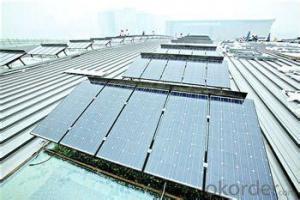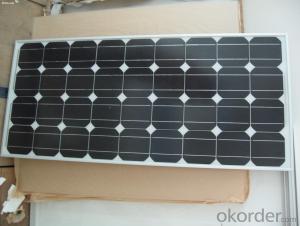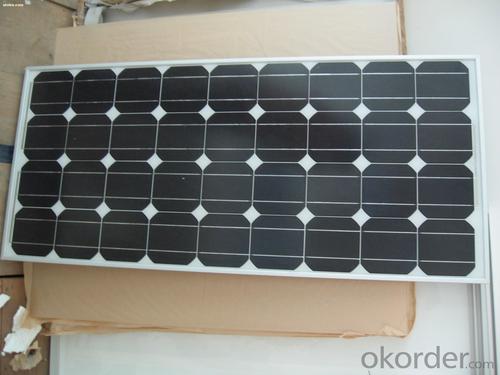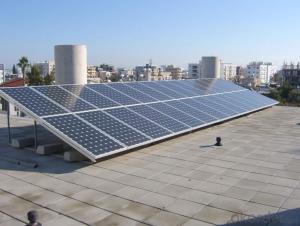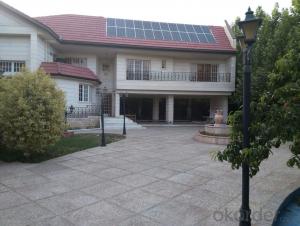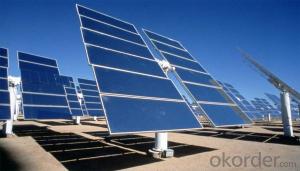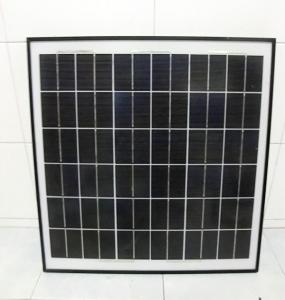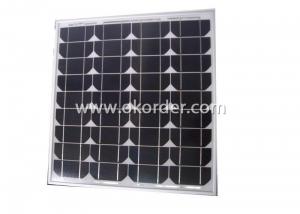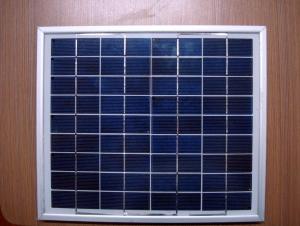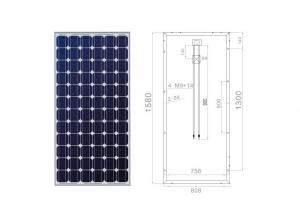Solar Panels in South Carolina - Solar Panel System, Solar Panel, Solar Module
- Loading Port:
- China main port
- Payment Terms:
- TT OR LC
- Min Order Qty:
- 1 pc
- Supply Capability:
- 10000000 pc/month
OKorder Service Pledge
Quality Product, Order Online Tracking, Timely Delivery
OKorder Financial Service
Credit Rating, Credit Services, Credit Purchasing
You Might Also Like
Quick Details
| Place of Origin: | Guangdong China (Mainland) | Brand Name: | sunny energy | Model Number: | SEM-200W-P |
| Material: | Polycrystalline Silicon | Size: | 1482*992*50mm | Number of Cells: | 6*12pcs |
| Max. Power: | 215W | certificate: | IEC,CSA,MCS | weight: | 24.5kg |
| lifespan: | 25years | cell: | Motech | leadtime: | 15~25days |
| sample: | available |
Packaging & Delivery
| Packaging Detail: | 2pcs in one carton,and we could also package as your request.. |
| Delivery Detail: | 25days |
Specifications
solar module:
1)High quality & efficiency
2)CSA/IEC/CEC certificate
3)Pm is notless than 90% in 10 yrs
and 80% in 20 yrs
high efficiency 200w poly solar module
| Characteristics | SEM-190PB205 | SEM-195PB205 | SEM-200PB205 | SEM-210PB205 | SEM-215PB205 |
| Maximum power(Pm) | 190.0W | 195.0W | 200.0W | 210.0W | 215.0W |
| Power Tolerance | ±3% | ±3% | ±3% | ±3% | ±3% |
| Voltage at max power(Vmp) | 34.9V | 34.9V | 34.9V | 34.9V | 34.9V |
| Current at max power(Imp) | 5.44A | 5.58A | 5.73A | 6.02A | 6.16A |
| Open circuit Voltage(Voc) | 43.2V | 43.2V | 43.2V | 43.2V | 43.2V |
| Short circuit current(Isc) | 5.98A | 6.15A | 6.3A | 6.62A | 6.78A |
| Operating Temperature | -40°Cto+85°C | -40°Cto+85°C | -40°Cto+85°C | -40°Cto+85°C | -40°Cto+85°C |
| Maximum System Voltage | 1000V | 1000V | 1000V | 1000V | 1000V |
| Maximum series Fuse Rating | 15A | 15A | 15A | 15A | 15A |
| Standard Test Condition | Irradiance 1000W/sqm,Module temperature 25°C,AM=1.5 | ||||
| Mechanical Characteristics | |||||
| Solar cell:Polycrystalline silicon solar cell 156×156mm(6inch) | |||||
| No.ofcells and connections:72=6×12pcs | |||||
| Dimension of module:1482×992×50mm(58.3×39×2inch) | |||||
| Weight:24.50kg | |||||
| Junction Box:Ip65 rated | |||||
| Packing Configuration:2Pcs/CTN,1510×1020×120mm(59.5×40.1×4.7inch) | |||||
| Warranty: Pm is not less than 90% in 10 years and 80% in 25 years | |||||
| Resistances:227g stell ball fall down from 1m height and 60m/s wind | |||||
| Temperature Coefficients | |||||
| Noct:48°C±2°C | |||||
| Current temperature coefficient:0.06±0.01%/K | |||||
| Voltage temperature coefficient:-(78±10)MV/K | |||||
| Power temperature coefficient:-(0.5±0.05)%/K | |||||
| IEC 61215 ed.2, IEC61730 and UL-1703 | |||||
- Q: Please, I want a good definition. :DD
- Solar panels are used to gather solar energy from the sun. Solar panels help maintain a clean and sustainable environment; using solar panels to gather the sunlight is a type of renewable energy. After collecting sunlight, the panels convert the energy into electricity
- Q: Can solar panels be installed on golf courses?
- Yes, solar panels can be installed on golf courses. In fact, golf courses provide ample open space and sunlight exposure, making them suitable for solar panel installations.
- Q: How much space do I need for solar panels?
- The amount of space you need for solar panels depends on various factors such as the size and efficiency of the panels, your energy requirements, and the available sunlight. Generally, you'll need around 100 square feet of unobstructed roof space per 1 kW of solar panels. However, it's best to consult with a solar installer who can assess your specific needs and provide an accurate estimation.
- Q: If I put a 5000 watt solar panel kit on my roof in Dublin (Ireland) - how much electricity would I realistically expect to get?An educated guess at a percentage of 5000w would do.
- This is dependent on sun angle, clear sky, shadow interference, clouds, etc. First if you purchased the PV panels and they are rated for 5 kW, the factory rating is based on a particular incident energy, 000 watts/square meter, 25 degrees C and an AM of .5, reaching the panels. It is more likely that you will not obtain this same level in the open air. If we assume you will get 80%, then the maximum kW would be closer to 4kW. This will be produced during peak, clear days with the panels placed perpendicular to the sun at all times during peak radiance times. When the sun first comes up and later when it is going down, there will be more than the thickness of .5 atmospheres between you and the sun, so the radiant energy hitting the solar panels drops off. Total energy is watts time hours. I would expect you PV system to produce about 750 kW-Hr of energy during a clear summer day at peak solar height. Hope this helps, NewtonLaw
- Q: I'm looking for some advice on hot water solar panels. I'm trying to save some money on electricity. A neighbor has been suggesting solar powered equipment for some time now, and I think he's right. It does save quite a bit of money in the long run. They're kind of expensive though, so I'm looking for cheaper alternatives.
- I worked for a plumbing service that offered hot water solar panel installs and replacements. I've replaced perfectly good solar panels for people who wanted to upgrade to the latest. We had piles and piles of panels out behind the shop. We use to scrap the copper and sell the glass panes. A few people would ask to scavenge panels and the boss would let them have it cheap, just to move some of the stuff. I would do the same. I'd find a local installer and see what they do with the leftovers. Chances are, if you searched diligently, you could probably find panels in good shape and use them to supplement your energy usage. Bear in mind, solar hot water system are very different from standard systems. They usually have a much larger storage tank. Typically 80-20 gallons compared to 40. They have a circulating pump and temperature sensors to move the heated water from the panel into the tank. These larger hot water heaters/tanks have much better storage and insulation to keep the water temperature that is generated during the day to last into the evening when people are home to use the shower and wash clothes to take advantage of solar heat. It's not just a matter of getting a panel and slapping it up. There's are technical aspects that need to be followed and if you don't know them, I would advise against doing it yourself. Study up on it and see if it's something you want to tackle on your own before you go too far doing legwork to find out details that might be cost prohibitive or too complicated. Good luck.
- Q: I have been thinking about getting solar panels for my house. What do you think I should get? Companies? Prices? I also have another question. How much energy can a small solar panel produce?
- so, you think that the best idea is to just keep focusing on oil and not to try to compete? EVERY CON I've talked to on here goes on and on about how green energy is a bad idea? yet, here's China, with a focused goal and actually making it happen... wonder how far we would be in the US without the cons fighting us every step of the way... how's that buggy whip business going cons? THAT'S what we mean when we say thanks to Republicans do you think green energy isn't going to happen? China's already doing it... we can either catch up, or give up... and give up has a big unempmloyment rate attached to it...
- Q: how much power is generated with solar panels? also please give me links for that information.and how much would the costs be for this alternative energy source?
- If you put 'solar world statistics' into a search engine, you will discover that there are many statistics that are being heavily contested. Picking up the truth from among hype is the task. Solar panels typically have a rated maximum output of about 0 watts per sq metre. But actual delivery to grids of kWh would point to a number closer to 4 watts / sq M. on a 24 hour basis. Grid management is thus cautious about yield claims when history points to only /8 of rated maximum output. There may be some inappropriate expectations, when a solar roof is first powering the building, and only selling excess to the grid.
- Q: Can solar panels be used to power a sports stadium?
- Yes, solar panels can be used to power a sports stadium. By installing a sufficient number of solar panels on the stadium's roof or surrounding areas, the captured solar energy can be converted into electricity to power various systems within the stadium, including lighting, heating, ventilation, and other electrical equipment. This can reduce the reliance on traditional energy sources and provide a more sustainable and environmentally friendly solution for powering sports stadiums.
- Q: Can solar panels be used to power a construction site?
- Yes, solar panels can be used to power a construction site. They can provide a sustainable and renewable source of energy, reducing the need for traditional fuel-based generators and minimizing carbon emissions. Solar panels can be installed on rooftops or on portable structures, providing electricity to power tools, lighting, and other equipment required on a construction site. Additionally, excess energy generated by solar panels can be stored in batteries for use during non-sunlight hours, ensuring continuous power supply.
- Q: Can solar panels be damaged by hail or strong winds?
- Yes, solar panels can be damaged by hail or strong winds. Hailstones can cause cracks or dents on the surface of solar panels, affecting their efficiency. Likewise, strong winds can potentially dislodge or break the panels, leading to their damage or complete destruction. It is important to ensure proper installation and consider protective measures, such as using impact-resistant glass or adding extra support structures, to minimize the risk of damage from hail or strong winds.
Send your message to us
Solar Panels in South Carolina - Solar Panel System, Solar Panel, Solar Module
- Loading Port:
- China main port
- Payment Terms:
- TT OR LC
- Min Order Qty:
- 1 pc
- Supply Capability:
- 10000000 pc/month
OKorder Service Pledge
Quality Product, Order Online Tracking, Timely Delivery
OKorder Financial Service
Credit Rating, Credit Services, Credit Purchasing
Similar products
Hot products
Hot Searches
Related keywords
